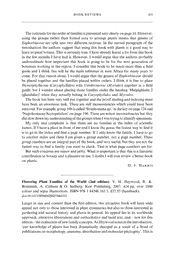
Flowering Plant Families of the World (2nd edition). V. H. Heywood, R. K. Brummitt, A. Culham & O. Sedberg PDF
Preview Flowering Plant Families of the World (2nd edition). V. H. Heywood, R. K. Brummitt, A. Culham & O. Sedberg
BOOK REVIEWS 435 Therationalefortheorderoffamiliesispresentedveryclearlyonpage10.However, using the groups rather than formal taxa to arrange plants means that genera of Euphorbiaceae are split into two different sections. In the second paragraph of the introduction the authors suggest that using this book with plants is a good way to learntropicalbotany.Thisiscertainlytrue.Ihavealreadylearntalotfromthisbook in the few months I have had it. However, I would argue that the authors probably underestimate how important this book is going to be for the next generation of botanists working in the region. I consider this book to be much more than a field guide and I think this will be the main reference in west Africa for many years to come.Forthatreasonalone,IwouldarguethatthegeneraofEuphorbiaceaeshould be placed together and the families placed within orders. I think it is fine to place Dioncophyllaceae (Caryophyllales) with Combretaceae (Myrtales) together in a field guide, but I wonder about placing those families under the heading ‘Malpighiales 2 (glandular)’ when they actually belong in Caryophyllales and Myrtales. Thebookhasbeenverywellputtogetherandtheproofreadingandindexingmust have been an enormous task. There are still inconsistencies which could have been removed.Forexample,group16biscalled‘Strephonemagp.’inthekeyonpage124and ‘Napoleonaeae-Scytopetalum’onpage196.Theseareminorinconsistenciesbutthey didslowdownmyunderstandingofthegroupswhenIwastryingtoidentifyspecimens. My only real complaint is that there are no families in the index of scientific names.IfIhaveaplantinfrontofmeandIknowthegenusthefastestwaytofindit istogototheindexandfindapagenumber.IfIonlyknowthefamily,Ihavetogo to another index and there I am given a group number, not a page number. These groupnumbersareanintegralpartofthebook,andveryuseful,buttheyarenotthe fastest way to find a family you want to check. That is what page numbers are for. Butsuchconcernsareminorandpetty.Whatisimportantisthatthisisafantastic contributiontobotanyandapleasuretouse.IdoubtIwilleverreviewabetterbook on plants. D. J. Harris Flowering Plant Families of the World (2nd edition). V. H. Heywood, R. K. Brummitt, A. Culham & O. Sedberg. Kew Publishing. 2007. 424 pp, over 1000 colour and sepia illustrations. ISBN 978 1 84246 165 5. £27.95 (hardback). doi:10.1017/S0960428607064335 Larger in size and content than the first edition, this attractive book will have wide appealnotonlytothoseinterestedinplantsystematicsbutalsotothoseinterestedin gardening and natural history and plants in general. Its appeal lies in its worldwide approach,attractiveillustrationsandauthoritativeandlucidtext,and–newforthis edition–theevaluationofnewfamilyconcepts.AsHeywoodnotesintheintroduction, ‘our knowledge of plants has been dramatically changed as a result of a flood of publicationsonmorphology,anatomy,distributionandmolecularphylogeny’.Thisis 436 BOOK REVIEWS inpartreflectedbythenumberoffamiliesinthisvolumeincreasingfrom306inthe 1978editionto506. Inthislastrespect,theappearanceofthisbookisverytimelybecause,overthelast 10 years or more, the new findings from DNA sequencing have redefined many family concepts, some of which were expected, others welcome and yet others seemingtoraisemoreproblemsthantheysolve.Manyofthesestudiesarepublished in new, very expensive, specialized journals that are not available to the general readernorindeedtotaxonomistsoutsidethe‘developed’world.Thisbookprovides a very accessible and, more importantly, authoritative balanced view of these new family concepts. Asinthelastedition,foreachfamilythecommonandscientificname,numberof species and genera, distribution, description, classification, economic uses and, new to this edition, a short list of salient references are given. Continuing from the previous edition, the botanical information is concise, comprehensive and clearly presented(notaneasythingtodo!).Alsonewtothisedition,itbeginswithadouble- spread illustrating the arrangement of the mega-groups and orders as currently accepted. This is followed by an illustrated glossary for morphological terms. It would have been helpful here to explain terms such as clade, monophyletic, paraphyletic and polyphyletic, which are used frequently in the text, but which may notbe familiarto thegeneral reader. The book endswith anindex toscientific and common names. The layout follows that of the previous edition with, in addition to the text, illustrationsformanyfamilies,and,inabox,aworldmapshowingdistribution,the numberofgeneraandspecies,andeconomicuses.Theauthorsnoteintheforeword thattheinclusionofmapsisanunusualfeatureandtheyareindeedusefultotakein family distribution at a glance. However, care should have been taken, especially where family concepts have changed since the last edition, to check their accuracy. For example, a quick scan for families for Peninsular Malaysia shows that several families not known from Peninsular Malaysia (Berberidaceae, Callitrichaceae, Carle- maniaceae,Centrolepidaceae,Chenopodiaceae,Elatinaceae,Gisekiaceae,Gelsemiaceae, Laxamanniaceae,Hyacinthaceae,Valerianaceae)areillustratedaspresent,whilesome that are indigenous (Alismataceae, Joinvilliaceae, Petrosaviaceae, Potamogetonaceae and Rhamnaceae) are omitted. The standard of illustration, as expected from a Kew publication, is excellent – beautiful watercolours shine from the page. Some families are lavishly illustrated in colour; many others in the brown sepia so characteristic of the last edition. Most welcomeisthegoodrepresentationoftropicalplants,whichareoftennotillustrated elsewhere. But why do illustrations fizzle out in the monocots where many families are not illustrated at all, including several with horticultural importance, such as Agapanthaceae,HeliconiaceaeandHyacinthaceae,orwithcommercialvalue,suchas Agavaceae and Dioscoreaceae? Under the heading ‘classification’, an up-to-date assessment of the subfamily divisions is provided together with a balanced evaluation of DNA sequencing in BOOK REVIEWS 437 elucidating family relationships. The new addition of a short list of pertinent ref- erences is particularly useful. Twoofthemostcommonquestionsthelaymanasksaboutplantsis‘Canyoueat it?’and‘Doesithaveanyvalue?’(Thethirdquestionis‘Isitpoisonous?’)Thesection on economic uses provides the answers and will be of great interest to the general reader, besides being a ready reference for the correct names of useful plants. My one serious criticism is the strange use of ‘Malaysia’ for ‘Malesia’, which results in totally misleading distributions, as for example ‘East Malaysia’ (which is Sabah and Sarawak in Borneo) for East Malesia (New Guinea region) and ‘West Malaysia’ (Peninsular Malaysia) for West Malesia (Peninsular Malaysia, Sumatra, Java, Borneo and the Philippines). Was this caused by a hiccup in ‘spellcheck’? Icannotbelieveitwasintendedbytheauthors.Atleastanerratumslipshouldhave been included in each book before distribution. In conclusion, this volume is outstanding for its worldwide coverage, its author- itative text, and excellent illustrations and layout at a very affordable price. In addition,itisthefirstpublicationthatdescribesmodernfamilyconceptsinabalanced andaccessibleway.Forallthesereasons,notleastbecauseitpresentsfloweringplants asattractiveandinteresting,itshouldbeessentialreadingforstudentsandteachers, gardeners andthose interested inplants,natural historyandbiodiversityingeneral. I read this volume with great pleasure and interest as will many others. The four authorsdeservecongratulationsforitstimelypublication. R. Kiew
